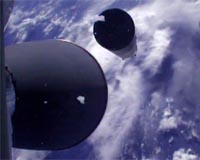 |
Washington (AFP) July 19, 2009 Wernher von Braun, a German engineer considered the father of Nazi Germany's V2 missile, was also a key player in the construction of the Saturn V rocket that helped US astronauts land on the moon on July 20, 1969. Born in 1912, von Braun was "one of the most important rocket developers and champions of space exploration during the period between the 1930s and the 1970s," the US space agency NASA says on their website. The German-born engineer became a US citizen in 1955 and died in Virginia in 1977 of liver cancer, aged 65. Von Braun was passionate about space flight from an early age and joined the German rocket society Verein fur Raumschiffarht in 1929 at the age of 17. To pursue his dream of building rockets, he joined the German army in 1932 to work on development of the ballistic missile, simultaneously pursuing his studies and obtaining a doctorate in physics in 1934. Von Braun is famous for having lead "the rocket team" that developed the first ballistic missile -- the V-2 -- for the Nazis during World War II. The rockets were produced in the Nordhaussen factory near the Dora concentration camp, which is known to have used forced labor. Thousands of workers are believed to have died in production of the V-2 missiles von Braun helped create, and NASA writes that "scholars are still reassessing his role in these controversial activities." The V-2s, which were 15 meters long and weighed 12 tons, could travel at more than 5,000 kilometers an hour and were equipped with motors powered by liquid fuel. They could carry explosive charges that weighed in at more than a ton for 750 kilometers and used their capacity to devastating effect in September 1944, when they were used on London. The technology that powered the missiles was eventually used the first rockets and missiles developed by the United States and the Soviet Union. By the beginning of 1945, von Braun realized that Germany had lost the war and began to organize his surrender, along with 500 of Germany's best scientists and researchers, to American forces. During the 15 years following the war, the German engineer worked with his team and the material and equipment they had transferred from Germany to the United States to develop ballistic missiles, including the Jupiter missile. Von Braun justified his decision to surrender to the United States by saying that he and his team would not have been paid enough by England, and were afraid of the Russians. In 1960, his rocket development center was transferred from the Army to NASA, which had just been created, and was given instructions to work on the construction of the giant Saturn rockets. His mandate included work on the all-important Saturn V, which powered both the Apollo 8 mission that sent astronauts in orbit around the moon, and the Apollo 11 mission that successfully put the first men on the Earth's closest neighbor. In 1970, NASA asked von Braun to head the space agency's strategic planning efforts in Washington. He agreed, moving from his home in Huntsville, Alabama, but in 1972, he decided to retire from NASA and took a job with Fairchild Industries in Maryland. Before his death in 1977, he authored a book on the history of rocket technology and space travel and is himself the subject of numerous works on space and science. Share This Article With Planet Earth
Related Links Rocket Science News at Space-Travel.Com
 SpaceX Successfully Launches Satellite Into Earth Orbit
SpaceX Successfully Launches Satellite Into Earth OrbitLos Angeles CA (SPX) Jul 14, 2009 Space Exploration Technologies has announced the successful launch of Falcon 1 and delivery of Malaysia's RazakSAT into the correct orbit. Falcon 1, a two-stage, liquid oxygen/rocket-grade kerosene vehicle designed and manufactured by SpaceX, lifted off Monday, July 13, at 8:35 pm (PDT). Lift off occurred from the Reagan Test Site (RTS) on Omelek Island at the U.S. Army Kwajalein Atoll (USAKA) ... read more |
|
| The content herein, unless otherwise known to be public domain, are Copyright 1995-2009 - SpaceDaily. AFP and UPI Wire Stories are copyright Agence France-Presse and United Press International. ESA Portal Reports are copyright European Space Agency. All NASA sourced material is public domain. Additional copyrights may apply in whole or part to other bona fide parties. Advertising does not imply endorsement,agreement or approval of any opinions, statements or information provided by SpaceDaily on any Web page published or hosted by SpaceDaily. Privacy Statement |